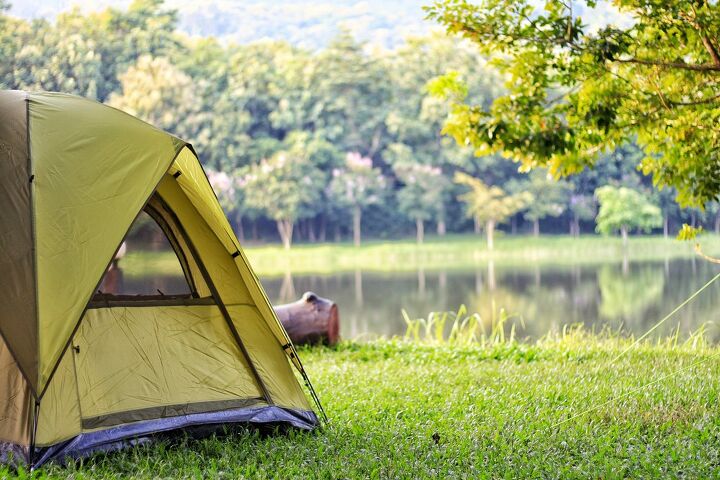Can You Put A Tent In The Dryer? (Find Out Now!)

It’s the end of the camping season, and you are putting away your gear for the winter. Your tent has provided many enjoyable nights out in the wilderness. Unfortunately, it has accumulated its fair share of dirt and stains. As you contemplate cleaning your tent, you wonder if you can put a tent in the dryer?
Don’t be tempted to put your camping tent into the dryer to speed up the cleaning process. The heat is bad enough on the coatings that most manufacturers use to create a waterproof surface. The tumbling action of the dryer, even without the heat, can do irreparable damage to the tent fabric, seams, and nylon mesh windows.
There are other, much better, and less damaging ways to clean and dry your tent. The best advice you can get about cleaning your tent is the manufacturer’s recommendations. However, some tips and tricks can help you keep your tent clean and serviceable for many camping seasons.
Why is the Dryer Off-Limits for My Tent?
There are several good reasons not to put your tent into the dryer even without using the heat. Tents are constructed in special ways and with special materials. These materials don’t deal well with the heat or the tumbling action inside the dryer.
Tents Are Tough, but Not Tough Enough
Quality tents are extremely tough where it counts. The ability to withstand winds, rain, other harsh environments are key factors of good tent design and manufacture. However, tents are not designed for the extreme heat of household dryers. Exposing your tent to these kinds of heat can cause problems in several areas.
- Fabric Damage – The high heat of a normal household dryer may not damage your clothing, but it can stress and damage your tent. The lightweight manmade materials that are used in modern tents can suffer from the heat. The material may warp or stretch, changing the shape of your tent. In some cases, the fabric may even melt.
- Laminated Seams – Many new tents don’t have mechanical stitching. Stitched seams have long been a source of leaks in tents. New methods of laminating materials together prevent needle punctures and leaks. However, the heat of a dryer may cause the laminated seams to weaken or fail, leaving with pieces of a tent instead of a tent.
- Zippers and Connectors – We are long past the days of brass and steel zippers and connectors. Even the most expensive tents use nylon zippers and connection points. These nylon components are strong, lightweight, and resist corrosion. What they don’t handle well is heat.
- Material Coatings – Veteran tent campers are aware of the need to protect and sometimes renew the protective waterproof coatings applied to their tent materials. Even modern manmade materials need a good protective coating. The high heat from a dryer can destroy the waterproof coating on your tent material.
The heat from a dryer is no friend of your tent. Using a dryer may seem like a time-saving prospect, but in the end, it will shorten the life of your tent and cause other problems that may not appear until the worst possible time.
Tents Are Not Made to Take Beating
Modern lightweight tent materials are not meant to withstand the physical abuse of a dryer. The tumbling action can beat your tent to death. The material of the tent will lose its body and become limp and soft. The seams can be damaged to the point they weaken and fail. Fitting and zippers can break, leaving you without the means to erect the tent.
What is the Right Way to Dry a Tent?
You can dry a tent after washing or cleaning several ways. The best advice is to let the tent material dry naturally without extra help from dryers, fans, or heaters. We suggest one of these methods for drying your tent after cleaning.
Dry Your Tent Where It Wants to Live
Tents are designed and manufactured to live outdoors. It shouldn’t be any wonder that the best place to dry your tent is in its natural environment. However, there are some tips and tricks for drying your tent to help preserve the material’s shape, integrity, and waterproofing.
- Choose a warm day to dry your tent, erect the tent normally and open the doors and windows to allow the best air circulation.
- Try to keep your tent out of direct sunlight. Direct sunlight with high amounts of ultraviolet radiation can shorten the lifespan of your tent. However, some sunlight is beneficial for its antibacterial properties and may help prevent mold and mildew
- A day with a moderate breeze will speed up the drying process. However, avoid extremely gusty conditions as this can stress your tent and cause damage. Low humidity days are also a better choice.
Indoor Options for Drying your Tent
If outdoors isn’t an option because of the season or the weather, you are often forced to dry your tent indoors. However, there are some things to consider when you must dry your tent indoors.
- If possible, find a space such as a garage where you can erect your tent for drying. This is the most efficient way to dry your tent and preserve its shape.
- If you don’t have space to erect your tent for drying, the next best option is to hang the tent. Try to find a place to hang the tent to allow as much air circulation in and around the tent as possible. Support the tent, so you preserve as much of the natural shape.
- If nothing else is available, a well-ventilated room in your home can be used. As the tent dries, it may accumulate water around the bottom, dripping onto flooring or carpet.
- Avoid hanging your tent, so that deep creases are in the tent material. However, creases are hard to dry properly and can invite mold and mildew growth.
- Don’t put a space heater under or around your tent as it dries. This concentrated heat can do the same kind of damage as a clothes dryer.
Drying a tent when the weather prevents you from going outside and limited space can be a challenge. Paying attention to the fabric, avoiding creases, and ensuring plenty of air circulation is the key to successfully drying your tent.

Dennis is a retired firefighter with an extensive background in construction, home improvement, and remodeling. He worked in the trades part-time while serving as an active firefighter. On his retirement, he started a remodeling and home repair business, which he ran for several years.
More by Dennis Howard


















![12 Washing Machine Brands to Avoid [with Recall Data]](https://cdn-fastly.upgradedhome.com/media/2023/07/31/9075781/12-washing-machine-brands-to-avoid-with-recall-data.jpg?size=350x220)








